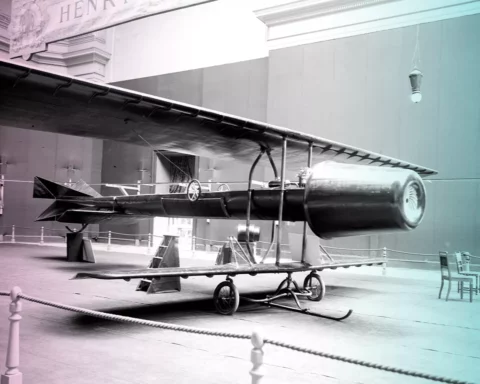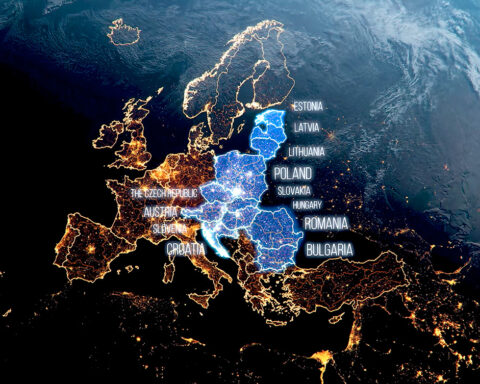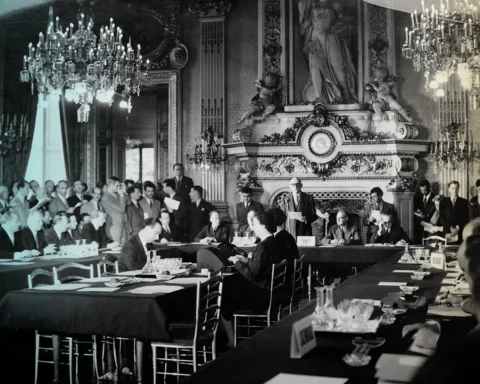German historian Karl Schlögel was one of the first Western Europeans who “discovered” Central-Eastern Europe in the 21st century. “Our awareness of Europe is asymmetrical. Eastern Europeans are far more interested in Western Europe than the other way around. This is because we in the West are comparatively uninformed and disinterested,” he wrote in October 2004, just after eight post-communist countries joined the European Union.
Four years later, he published “Die Mitte liegt ostwärts: Europa im Übergang” (The center lies eastwards: Europe in transition) – the series of essays in which he described the importance of the Eastern part of Europe, expressing that eastward expansion of the EU would become one of the central themes in Europe in subsequent decades.
His words were confirmed in August 2022 by German Chancellor Olaf Scholz. “The center of Europe is moving eastward,” Scholz said during his keynote speech at Charles University in Prague, echoing Schlögel’s sentiments. The context of these words is obvious: the war in Ukraine. Shortly after its outbreak (February 24, 2022), Europe split into two camps. While Western states began to hesitate, wondering what policy to pursue towards Russia, countries closer to Ukraine immediately rushed to its aid, supporting those attacked logistically or taking in refugees.
This division continued for another year. While Central Europe – supported by the US and the UK – tried to help Ukraine as effectively and quickly as possible, Western European countries regularly came more slowly and less efficiently. Yes, they, too, are getting involved on the side of Ukraine, but it is hard to free oneself from the perception that it always comes with resistance. And there is no action without a reaction. When the greatest armed conflict on the continent since the end of the Second World War is underway, there is a turn towards those who take the side of good – and in this case, that side is chosen primarily by Central Europe. These choices are followed by politics, as Scholz’s words confirm. This is one of the most significant changes in Europe in the last year. What does this mean for CEE countries?
European center of gravity
“Scholz is right. The voices of Central and Eastern Europeans are being listened to more and taken more seriously in the councils of Europe. With a major war within its borders, Europe is more about hard power now than before. Having a Central and Eastern Europe that takes security seriously has an impact,” said Prof. Timothy Garton Ash, a European historian at St. Antony’s College, Oxford, as quoted in a January 2023 article in the “New York Times”.
Our awareness of Europe is asymmetrical. Eastern Europeans are far more interested in Western Europe than the other way around. This is because we in the West are comparatively uninformed and disinterested
Karl Schlögel
Of course, nothing is free for Central Europeans, not even their rise of hard power on the continent. There are no free lunches in international relations. Countries of the region are taking a much bigger risk by pursuing an open policy of helping the Ukrainians against the Russians than the West. If this strategy fails, they will be next in line – and the Western countries will still have time to find a compromise with Vladimir Putin.
So far, the policy of containing the Kremlin’s aggressive urges is paying dividends. Since the EEC countries have taken the main burden of these measures, the balance of power in Europe has started changing. It is noticed not only by Chancellor Scholz. “President Biden’s visit to Poland (in February 2023) is perceived as a correction to the overwhelming dominance of western member states in EU politics,” wrote Prof. John Keiger, a historian from Cambridge University, in “The Spectator” weekly. “The time when a French President like Jacques Chirac could tell the Eastern European states that they would be well advised to keep quiet has long passed,” he added.
The same tune is heard in other places. “One thing is clear: an important pivot towards NATO’s eastern flank is underway,” wrote Roger Boyes, international editor of British “The Times” daily. “It does feel as if the center of gravity has shifted eastwards in Europe,” commented Gen. Ben Hodges, the former commanding general of US Army Europe.
However, it would be a mistake to see the entire Central European region as a monolith. Each of the 12 countries that make up the Three Seas Initiative has its own policies, agenda of issues – and often conflicting interests. This is also true in relation to Russia. The outbreak of war has highlighted many of these differences – but has also blurred them in many places. In many areas, it has turned out that the Central European community of destiny is a more important point of reference than the temptation to maintain good relations with Moscow. And this fundamental U-turn could be observed even in countries that were perceived as trusted allies of Russians for many years.
Tectonic shift
Since the start of the war in Ukraine, processes have been taking place in Europe that for decades seemed impossible. An example? The plans of Finland and Sweden to become members of NATO. Both countries – which lie in the immediate vicinity of Russia (and formerly the USSR) – have adhered to the principle of neutrality for a very long time. After the Russian aggression, they rejected this rule by applying for membership in the Alliance. “Sweden and Finland have changed their defense postures, the Baltic states are standing firm, Romania is strengthening its military position in the Black Sea,” underlined Gen. Hodges.
Romania can be treated as another example of a U-turn in regional policy towards Russia. Even at the beginning of the 21st century, Bucharest maintained good relations with Moscow. In 2003 both countries signed a treaty on good relations. Two years later, after the country acceded to NATO, Romanian President Traian Băsescu visited Moscow, where he urged moving past historical prejudice between the two states. But that was it. In 2007 Romania joined the EU. Its stance towards Russia since then has gradually deteriorated. After Russia annexed Ukraine’s Crimea in 2014, Traian Basescu was among the first to accuse the EU of being too slow to impose sanctions against Moscow. The same president who had visited Russia’s capital nine years earlier. The best proof of the tectonic shift in Romanian politics.
Russia’s aggression against Ukraine in 2014 accelerated many processes in the region. In 2015, the so-called ‘Bucharest Nine’ (B9) was constituted. A group of nine Central European countries (Bulgaria, the Czech Republic, Estonia, Hungary, Latvia, Lithuania, Poland, Romania, and Slovakia) created a platform for close defense cooperation. All countries which became members of B9 have two things in common: they were members of the Warsaw Pact and joined NATO after the collapse of communism. And the war that started in 2022 showed that they also share a common challenge: the threat from an aggressive Russia located in their immediate neighborhood.
Romanian authorities reacted quickly to the rise of instability in the region. Even before the war, military spending in this country was consistently increasing. In 2016 it amounted to 1.4% of the GDP. Three years later, it rose to 1.8%; in 2021, it achieved 2%.
The start of the war has only speeded up this process. In 2023 the government plans to spend 2.5% of GDP on defense. The country has already spent 300 million euros on Bayraktar TB2 drones from Turkey and is planning to buy Hermes 450 Watchkeeper drones and anti-aircraft warfare systems from Israel. Bucharest is also one of the most declared supporters of Ukraine during this conflict. From the beginning of the conflict, Romanian authorities have been helping Ukrainians with military equipment and humanitarian aid and giving a hand to war refugees. And this stance is shared by most Romanians. Polls show that 54% of citizens of this country support economic help for Ukraine, and 70% think that Russia is to blame for the war—the best confirmation of how Romanians have become immune to Russian propaganda.
False delusion of “Wandel durch Handel”
Romanians are not the only ones. Slovenia is also Ukraine’s solid ally in the war. Just before the first anniversary of this conflict, its government proposed EUR 100 million in economic help for Ukrainian companies. From the first day of the war, three Baltic countries and Poland were doing their best to help Ukraine. And even before this conflict, these states have loudly warned about Russian danger. It was they who, during the migration crisis on the border with Belarus, clearly indicated that this could be the start of a hybrid attack on EU and NATO countries. Previously, they had strongly criticized European countries that conducted their energy policy in close symbiosis with Russia. “Poland and the Baltic states did not doubt that the Nord Stream pipelines were part of a sinister strategy to make Europe dependent on Russian gas. They were proved right,” wrote Roger Boyes in “The Times.”
Of course, not all countries in the region speak with one voice. Each has a different geopolitical perspective and internal political dynamics, making their attitudes toward Russia and the conflict in Ukraine more nuanced. For instance, more than half of Slovaks would welcome a military victory of Russia over Ukraine – such an attitude must impact Slovakian politics. Slovak opposition has no qualms about criticizing the authorities’ actions supporting Ukrainians’ struggle. This makes it all the more important to recognize the ruling coalition’s efforts there. Slovakia is not only involved in military and humanitarian aid. In February 2023, Slovakia’s parliament voted a motion to recognize Russia as a state sponsor of terrorism and called its current regime terrorist.
Like Slovakia, the Czech Republic also had close relations with Russia before the outbreak of war, especially the president there was considered a pro-Russian politician. Nevertheless, Prague has unequivocally sided with Kyiv since 24 February 2022, being one of the leaders in sending military equipment to Ukraine. The war also highlighted political divisions in Croatia. For example, Croatian President Zoran Milanovic commented in January 2023 that Crimea would never return to Ukraine. But these words have been harshly criticized by other politicians. The Croatian government is a strong supporter of Kyiv. Another example of how a sense of responsibility for the region’s future takes precedence over short-term political games.
Some countries in the region still maintain a nearly open, pro-Russian narrative, for instance, Hungary and Austria. Bulgaria also has long avoided explicitly supporting Kyiv. But at the same time, these three countries have joined together with the other EU countries to unanimously adopt further sanctions packages hitting Russia. They, too, are helping – albeit perhaps more slowly and less effectively – Ukraine, if only by taking in refugees or sending fuel and humanitarian aid to Kyiv. And the longer the conflict lasts, the greater their involvement on the Ukrainian side.
Europe has long been convinced that it is possible to cooperate with Russia on an economic level. This was the thinking of the Western countries (especially Germany). The war showed how false this logic was. “Wandel durch Handel (change through trade) was not just a slogan. It was about knitting Russia with Germany through gas pipelines. It is now clear, despite so many unheeded warnings by the Central Europeans, how this dependency became an instrument used by the Kremlin to weaken and divide Europe,” wrote Judy Dempsey, one of the prominent commentators on security issues. Before February 2022, some Central European countries also succumbed to the false delusion of “Wandel durch Handel.”
But since Russian tanks crossed the Ukrainian border, the vast majority of CEE states have unequivocally sided with Ukraine. It is apparent that the former communist bloc countries are fully aware of this war’s major geopolitical challenge – not only for Ukraine but also for themselves. The year of the war was also a year of forging an awareness of the common destiny of the entire region.







